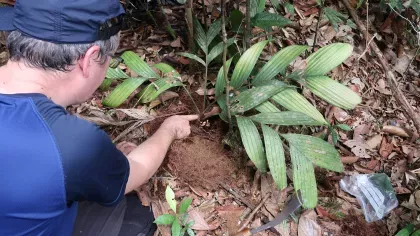22 March 2024
The palms of New Guinea
We’ve studied, mapped and illustrated all 250 species of New Guinea’s palms in a massive project spanning decades

New Guinea is the world’s largest tropical island and is one of the last great wilderness areas on Earth. It is home to more plant species than any other island, but these species remain very poorly known and understood.
Botanical knowledge in New Guinea has just taken a big step forward with the completion of the Palms of New Guinea, a 726-page book that documents and richly illustrates all 250 species of the island’s palms. The book can be downloaded as a PDF free of charge and will soon be available to purchase in physical form.
This work, led from Kew, was completed through a collaboration between nine botanical experts from Indonesia, Australia, Denmark, Switzerland, the USA and the UK, and a host of supporting partners from New Guinea itself.
A staggering 91 species new-to-science were described during the writing of the book. The 250 botanical illustrations that accompany the book were a labour of love for award-winning Kew artist Lucy T. Smith.
Here we share a few of our favourite New Guinea palms, and our experiences of studying these spectacular and important plants.

Sommieria leucophylla: the ultimate New Guinea palm.
The genus is only known from western New Guinea. When the project started, it was almost a mythical plant – with its beautiful, stiff leaves, chalky white on the underside, and bizarre fruit covered in pink warts.
As our work progressed, we discovered that it was more widespread than we believed previously and is fortunately not of immediate conservation concern.


Metroxylon sagu: the most important palm in New Guinea.
It is used in more ways than any other palm species by the people of New Guinea.
This is the true sago palm – starch washed from the stem is the staple carbohydrate for countless lowlanders. Young shoots can be consumed and the trunk is used to raise edible sago grubs. The leaves produce essential construction materials, especially thatch.
The sago palm forms vast, spiny and impenetrable stands in lowland swamp forests – the worst destination for botanical fieldwork!!!


Calamus zebrinus: one of 62 rattan species found in New Guinea
Of the 62 rattan species included in Palms of New Guinea, 32 were described as new-to-science during the project.
Rattans are spiny climbing palms and their strong, flexible stems (cane) are used for weaving and tying purposes. This species is used for making bow strings, as well as traditional waist-hoops and armbands.
It is viciously spiny! If you aren’t ensnared by its prickly whips, the ants which make often homes on the stem may finish you off.


Wallaceodoxa raja-ampat: described as new-to-science as recently as 2014
This graceful tree palm towers to 30m in height and has elegant, pendulous leaves. It is known only from the Raja Ampat islands at the far western end of New Guinea, where it is Critically Endangered due to land clearance for farming and the expansion of towns and coconut plantations.
Indonesian palm expert Charlie Heatubun named it for Alfred Russel Wallace, the legendary naturalist and early western explorer of New Guinea, who co-discovered the theory of evolution by natural selection.


Hydriastele simbiakii: one of a handful of riverbank specialists
These riverbank specialists (known as rheophytes) are adapted to life in the flood zone. It has multiple, flexible stems, which can regenerate if damaged and narrow leaflets that offer little resistance to fast-running water.
We discovered this palm in 2013 and named if for Victor Simbiak, our Indonesian field collaborator who drew the palm to our attention. Its coral pink flowers are especially beautiful.
We know this palm from a single site in the Tamrau Mountains. Though still forested, road-building in the area is a significant threat to the future of the forest.
_0481.jpg.webp?itok=-11Xjh4d)

Saribus pendulinus: a last-minute addition
This glorious fan palm nearly didn’t make it into the book because it was discovered so recently!
It grows in southern Papua New Guinea and was described in 2023 by Australian botanists John Dowe and Stephanus Venter. It produces cascades of red flowers that are followed by fruit like orange ping-pong balls.
The palm is Vulnerable to extinction, as it is found in only small populations in an area that is slated for development due to natural gas extraction.


Saving New Guinea’s palms
With their new insights into the taxonomy and distribution of New Guinea's palms from decades of study, the team were able to assess their conservation status of all 250 species, finding that at least 36% (and perhaps as much as 50%) are threatened with extinction.
New Guinea may seem like a wilderness, but in reality human impacts are keenly felt and intensifying. This book highlights the importance of taxonomy in underpinning the long-term preservation of this immeasurably valuable plant group - plants that bring huge benefits to the ecosystems in which they live, and the people that rely on them.



.jpg.webp?itok=SKtJrQSo)
